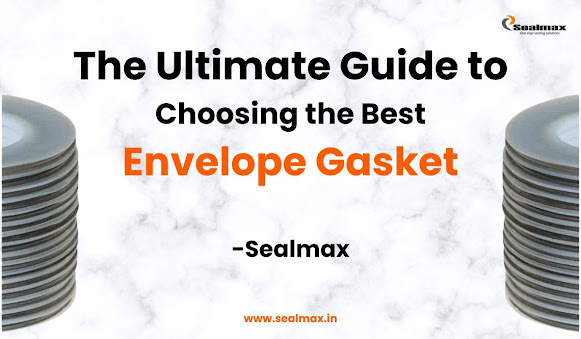The Ultimate Guide to Choosing the Best Envelope Gasket
In the world of industrial
processes, ensuring a leak-proof seal is paramount. Flanges, the bolted
connections between pipes and equipment, often rely on gaskets to achieve this
critical task. Among the various gasket types, envelope gaskets, also known as
jacketed gaskets, have emerged as a reliable and versatile solution. But with
an array of options available, selecting the best envelope gasket
for your specific application can be a challenge.
This comprehensive guide empowers
you to make informed decisions when choosing envelope gaskets. We'll delve into
their key features, explore different materials and inlay options, and guide
you through crucial selection factors.
Demystifying Envelope Gaskets: Design and Function
An envelope gasket comprises an envelope – a formed outer layer –
typically constructed from a flexible and chemically resistant material like PTFE (polytetrafluoroethylene), also
known as Teflon™. This envelope encases an inlay,
a core element that provides structural strength and specific performance
characteristics. The inlay material can vary depending on the application's
pressure, temperature, and media compatibility requirements.
The envelope's design allows for
a compression seal, where tightening
the flange bolts compresses the gasket, creating a tight seal between the
flanges. This compression also forces the inlay material to fill any minor
imperfections on the flange surfaces, further enhancing leak prevention.
Advantages of Envelope Gaskets: Why They Stand Out
Envelope gaskets offer several
advantages over traditional gasket materials like solid metal or spiral wound
gaskets:
Superior Chemical Resistance: The PTFE envelope provides excellent
resistance to a wide range of chemicals, making them ideal for applications
involving harsh or corrosive media.
Enhanced Sealing Performance: The combination of a flexible
envelope and a compressible inlay ensures a tighter seal, even under
fluctuating pressure and temperature conditions.
Broad Temperature Range: PTFE's inherent heat resistance allows
envelope gaskets to function effectively in extreme temperatures, both hot and
cold.
Reduced Emissions and Leak Rates: The superior sealing properties
minimize fugitive emissions, contributing to a cleaner and safer work
environment.
Ease of Installation: The flexible design simplifies installation,
reducing downtime during maintenance procedures.
Versatility: With various inlay options, envelope gaskets can be
tailored to a wide range of applications.
Choosing the Right Envelope Gasket: Key Factors to Consider
Selecting the optimal envelope
gasket requires careful consideration of several factors:
Application Requirements:
·
Pressure and Temperature: Ensure the chosen
envelope gasket can withstand the expected pressure and temperature ranges of
your application. Inlay materials like carbon steel or graphite offer
high-pressure capabilities, while expanded PTFE inlays excel in
high-temperature environments.
·
Media Compatibility: The gasket material must be
compatible with the fluids or gases it will come into contact with. Consider
chemical resistance charts and consult the manufacturer's recommendations for
specific media compatibility.
Flange Type and Size:
Envelope gaskets come in various
sizes and configurations to match different flange types and dimensions. Ensure
proper fit for optimal sealing performance.
Inlay Material Selection:
The inlay material plays a
crucial role in the gasket's performance. Common inlay options include:
·
Carbon
Steel: Provides excellent strength and high-pressure resistance for
demanding applications.
·
Graphite:
Offers a good balance of pressure resistance, chemical resistance, and heat
dissipation.
·
Expanded
PTFE: Ideal for high-temperature applications due to its excellent heat
resistance and self-lubricating properties.
·
Non-metallic
Inlays: Available in various materials like aramid fibers or mineral
fillers for specific chemical compatibility needs.
Budget: Envelope gaskets generally
fall within a moderate price range compared to some other gasket types.
However, the cost can vary depending on the size, material selection, and
required pressure rating.
Pro Tip: Always consult the
gasket manufacturer's technical specifications and recommendations to ensure
the chosen envelope gasket aligns perfectly with your application's demands.
Conclusion: Choosing the Envelope Gasket Champion for Your Needs
By understanding the key
features, benefits, and selection factors of envelope gaskets, you are
well-equipped to make informed decisions for your specific sealing
requirements. Remember, consulting with a reputable envelope gasket
manufacturer is always advisable. Their expertise can guide you through the
selection process, ensuring you choose the best envelope gasket that delivers
optimal performance and longevity in your application. Are you looking for envelope
gaskets suitable for your needs? We are just one step away. We, at Sealmax,
produce high-quality and reliable envelope gaskets. Contact our experts now at
+91 8983059377 or visit our website http://www.sealmax.in
Resource: https://justpaste.it/bfeb0



Comments
Post a Comment